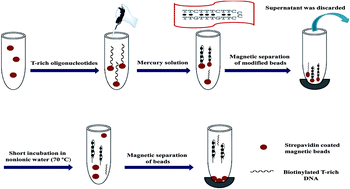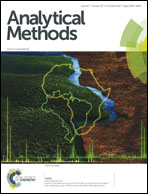Biomagnetic separation and pre-concentration of trace amounts of Hg2+ in biological samples based on T-rich oligonucleotide modified magnetic beads
Abstract
We report a simple and sensitive method for the analysis of trace mercury(II) (Hg2+) in biological samples, based on a magnetic bead (MB) separation/pre-concentration process and thymine-Hg2+-thymine (T-Hg2+-T) coordination chemistry. For this purpose, mercury specific aptamers are conjugated on magnetic beads, increasing the local concentration and serve as affinity probes to capture and separate trace amounts of the target. Then flow injection cold vapor atomic absorption spectrometry (FI CV AAS) is used for the determination of mercury. The analysis conditions are optimized and the performances of the proposed method are investigated. The limit of detection (LOD) obtained under the optimal conditions is 0.05 μg L−1 and the relative standard deviation (RSD) for the determination of 0.5 and 10.0 μg L−1 of Hg2+ is 3.78 and 2.93% (n = 5), respectively. The calibration curve for Hg2+ is linear from 0.12–87.5 μg L−1 with a coefficient of determination (R2) of 0.998, and the enrichment factor is about 280, which make it suitable for dilute solution analysis. The presented procedure is successfully applied for the determination of trace contents of Hg2+ in biological samples, and the accuracy is evaluated analyzing quality control materials (Seronorm™ Blood LOT NO 201505 and Urine LOT NO 2525).


 Please wait while we load your content...
Please wait while we load your content...